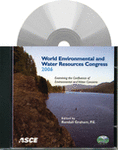Uncertainties in Discharges Determined from Index-Velocity Ratings
Publication: World Environmental and Water Resource Congress 2006: Examining the Confluence of Environmental and Water Concerns
Abstract
Time-series data describing the rate of flow of water (discharge), along with a description of the uncertainty in the reported discharges, are essential for most water-resources analyses, designs, and decision making. Direct measurement of discharge, however, is impractical; thus, most discharge records are developed using empirical ratings to estimate the discharge based on measured water stages. For many streams, however, the stage alone is insufficient to determine the discharge. Advances in hydroacoustics over the past decade have resulted in a family of rating methods that use the velocity measured for a subsection of the flow area ("index velocity") as a second parameter to estimate the discharge. While different methods have been utilized to incorporate the velocity data into discharge ratings, the method that is becoming widely accepted is the "Index-velocity method," in which an empirical rating between the index velocity and the cross-section mean velocity is developed. Index-velocity methods are being widely adopted and a few studies have examined the uncertainties in the resulting discharges from a statistical perspective. However, the uncertainties in these ratings have generally been lumped into "goodness-of-fit" statistics such as the standard error of regression. This approach precludes estimating the portion of the discharge uncertainty from different sources (e.g., instrument precision, temporal variations in the flow, percentage of the cross section measured, etc.). Without identification of the sources of uncertainty and quantification of their effect on the discharges, selection of instrument precision, number of sampling points, frequency and duration of index-velocity measurements, frequency and duration of rating measurements, etc. becomes a ‘seat-of-the-pants' exercise rather than a rational scientific design. This paper presents an overview of potential sources of uncertainty in index-velocity ratings and demonstrates use of reliability-analysis methods to synthesize these into an estimate of the uncertainty in the calculated discharges. An example applications to an index-velocity gauging station illustrates the relative significance of different sources of uncertainty.
Get full access to this chapter
View all available purchase options and get full access to this chapter.
Information & Authors
Information
Published In
Copyright
© 2006 American Society of Civil Engineers.
History
Published online: Apr 26, 2012
ASCE Technical Topics:
- Business management
- Continuum mechanics
- Cross sections
- Data analysis
- Dynamics (solid mechanics)
- Engineering fundamentals
- Engineering mechanics
- Flow (fluid dynamics)
- Flow measurement
- Fluid dynamics
- Fluid mechanics
- Fluid velocity
- Hydrologic engineering
- Management methods
- Mathematics
- Measurement (by type)
- Methodology (by type)
- Motion (dynamics)
- Practice and Profession
- Ratings
- Research methods (by type)
- Solid mechanics
- Uncertainty principles
- Water and water resources
- Water discharge
- Water discharge measurement
Authors
Metrics & Citations
Metrics
Citations
Download citation
If you have the appropriate software installed, you can download article citation data to the citation manager of your choice. Simply select your manager software from the list below and click Download.
